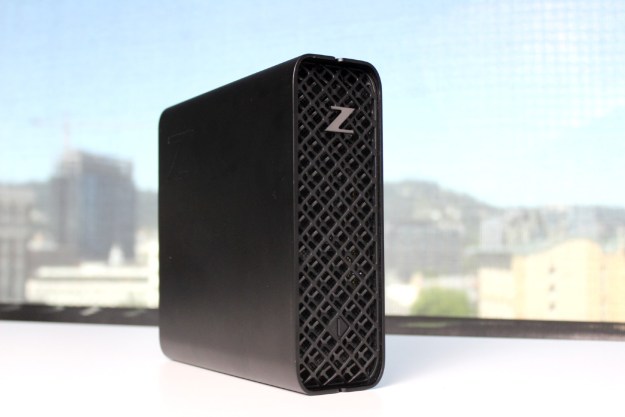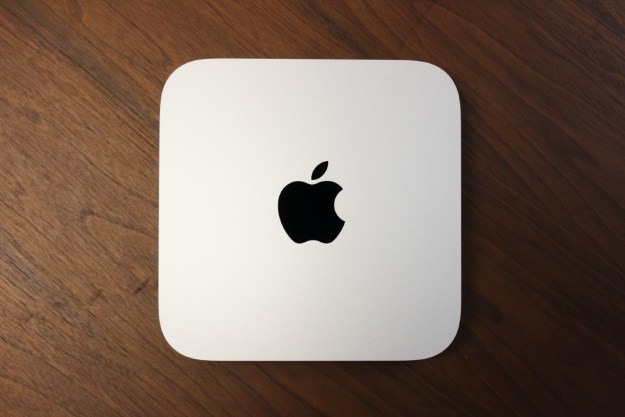
“The HP Z2 Mini G9 Workstation is both amazingly small and surprisingly powerful.”
- Powerful processor performance
- Compact
- User accessible internals
- VESA-mountable
- Solid design and build quality
- Odd port selection
- Gets hot and loud
A few years ago, it would have been hard to imagine a compact workstation like the HP Z2 Mini G9. It’s smaller than a shoebox, but has full desktop-class components within its black box.
It might not be something that can challenge the extreme efficiency of, let’s say, a Mac Mini or Mac Studio. Yet even with some odd design decisions and a hefty price tag, the HP Z2 Mini G9 remains a solid choice for a powerful yet compact PC.
Design

The Z2 Mini G9 Workstation is not meant to be flashy, but it has more going on than just a small black box. The front has a lattice-patterned grille, which hides the Z logo and the power button. Sidenote: The Z logo can even be rotated for when you stand the Z2 Mini G9 up on its side.
The size of the Z2 Mini G9 is important. It’s close to a cube at 8.3 x 8.6 inches, and it measures 2.7 inches thick. Interestingly, that’s about an inch wider and deeper than the Mac Studio. Apple’s desktop, though, is a full inch thicker.
The idea here is that the Z2 Mini will fit in many different scenarios – whether sitting right on your desk, attached to the back of your monitor, or even rack-mounted in a data center or server. I didn’t try the latter two use cases, but having the Z2 Mini G9 Workstation on my desk for a few weeks certainly made for a clean setup.
One of the compromises in making this PC so small is using an external power brick.
Of course, there are smaller PCs out there – even HP’s own Z2 Mini G5, for example. Like the Mac Studio, the emphasis here is on powerhouse performance balanced with a surprisingly small footprint.
One of the compromises in making this PC so small is using an external power brick. It’s pretty hefty, not unlike one you might find on a high-powered laptop.
The build quality of the Z2 Mini G9 is fairly robust. However, because the internals are user-accessible, this is far cry from the sturdiness of a unibody enclosure. Two of the panels on my unit weren’t perfectly aligned, allowing some give on the left side of the chassis. The rubber feet on the bottom, however, are quite strong, which should help avoid any accidents.
Ports and upgradability

The insides of the PC are incredibly easy to access. Just use the latch on the back, and the panel will easily pop open — no tools necessary. From there, you have access to the internals, though you’ll need to remove a couple of components to get to the good stuff. To reach the two DIMM slots for access to the memory, you’ll need to remove the fan, which is simple enough. From there, you’ll be able to add up to 64GB of DDR5 memory — and up to 4800MHz. My unit already came with that maxed out, of course.
The system also has two M.2 slots for up to a total of 8TB, both configured for RAID data storage. You’ll need to pull out the GPU to access the storage, though — and yes, that means you can even swap it out, too. So, even though it does require some component removal, that kind of user accessibility just isn’t possible with desktops like the Mac Studio.
The Z2 Mini G9 also doesn’t include a full-size SD card slot, unfortunately.
The HP Z2 Mini G9 has a ton of ports available, but I have to say: It’s a very odd selection. Most of your ports are on the back, where you’ll find three USB-A, two DisplayPort, an Ethernet jack, a power plug – and get this – four mini-DisplayPorts. Yup, you heard me right – four mini-DisplayPorts. In 2022. Those are the ports included on the GPU, of course, so it’s not really HP’s fault.
They do allow for the full DisplayPort 1.4 But this port has been on its way out for years now – and it’s to the point where it’s almost unheard of to be included in either laptops or desktops. Yet here, HP decided to include four. The worst part? These are, seemingly, in place of including HDMI, which remains the most common way to connect to external displays.
The Z2 Mini G9 also doesn’t include a full-size SD card slot, which would have been a convenient addition for creatives.
The one upside is the “Flex IO” slot on the back, a modular port that can be HDMI, VGA, or another specific connection you need.

Fortunately, HP does include some handy ports that sit a bit closer, found on the left side. There you’ll find two USB-C ports, an additional USB-A port, and a headphone jack.
The HP Z2 Mini G9 also features Wi-Fi 6E and Bluetooth 5.2 for wireless connectivity.
Performance
The HP Z2 Mini G9 Workstation uses desktop-class components, which is really what makes it stand out from other compact PCs. My review unit had a Core i9-12900K for its CPU, a 14-core processor with eight Performance cores, and eight Efficiency cores. These Performance cores have a base frequency of 3.20GHz and can supposedly boost up to 5.20GHz using Turbo Boost Max. Including this 45-watt chip is impressive in its own right, even if you don’t quite get the same performance as you would in a mid-tower PC.
Of course, it has all the benefits of the current-gen’s Ampere architecture but is specifically made for professional workloads in small form factors. In other words, it’s a match made in heaven for the HP Z2 Mini G9 Workstation – so long as you keep your expectations in check. The Z2 Mini G9 isn’t meant to compete with larger PCs, which will either have additional thermal headroom or simply much more powerful graphics cards. A larger tower like the Asus ProArt PD5 is a good example.

But we got some impressive numbers in both single-core and multi-core tests, beating everything but the most powerful gaming PCs we’ve reviewed.
Speaking of graphics, the HP Z2 Mini G9 Workstation comes with a low-profile RTX A2000 graphics card from Nvidia. This is certainly not your standard discrete GPU, and it’s the first in the line I’ve tested myself. This particular model comes with 12GB of GDDR6 memory, which you’d normally have to spring for an expensive RTX 3080 Ti to get. Of course, the A2000’s memory bandwidth is significantly lower than the RTX 3080 Ti at just 288 GB/s. That’s even half the bandwidth of the RTX 3060 Ti and less than what you get in the mobile version of the RTX 3060.
It’s also only a 70-watt card, which makes it closer to what you get in a laptop GPU in terms of TDP. More importantly, it’s based on the same GPU (GA106) as the RTX 3050 Ti and RTX 3060. That should give you a vague sense of what it’s capable of, but the extra VRAM really makes it an interesting (and unique) blend of hardware.
And as expected, the graphics land right in between the performance of laptops with the RTX 3050 Ti and RTX 3060. I tested the HP Z2 Mini G9 in 3DMark Time Spy, Fortnite, and Assassin’s Creed Valhalla. In both games, the system averaged over 60 fps (frames per second) with settings maxed out. As long as you stick to 1080p, you can certainly do some gaming on the side. Do keep in mind, though, that something like an RTX 3060 Dell XPS 17 will beat it in most 3D games.

Now, on the surface, that might not sound very impressive. This isn’t meant to be a dedicated gaming machine by any means.
But for the right tasks, the HP Z2 Mini G9 Workstation really shines. Despite the small size, the Z2 Mini G9 is a killer video editing and media machine. As tested in Pugetbench Premiere Pro and Handbrake, this little machine delivers a surprising amount of performance.
More powerful discrete GPUs will speed up exports and in applying GPU effects, but the Z2 Mini G9 was extremely smooth in video playback. Not quite as fast as the M1 Ultra in the Mac Studio, it’s on par with the performance of the M1 Max in the MacBook Pro 16-inch in terms of export times and GPU effects.
| Geekbench (single/multi) | Handbrake (seconds) |
Cinebench R23 (single/multi) | Pugetbench for Premiere Pro | PCMark 10 Complete | |
| HP Z2 Mini G9 Workstation (Core i7-12700K) | 2056 / 17175 | 55 | 1950 / 18233 | 931 | 7770 |
| Asus ProArt PD5 (Core i7-11700) | 1639 / 8110 | 111 | 1504 / 8866 | 627 | 6822 |
| Falcon Northwest Tiki (Ryzen 7 5800X3D) | 1599 / 10633 | 70 | 1450 / 14067 | 880 | 8215 |
| Dell XPS Desktop 8950 (Core i5-12600K / RTX 3060 Ti) | 1829 / 10819 | n/a | 1903 / 16798 | 708 | 7633 |
| Apple Mac Mini (M1) | 1744 / 7659 | 154 | 1519 / 7759 | 364 | n/a |
The Z2 Mini G9 can, however, get both hot and loud. All the exhaust is out the back, so you don’t want the vents pointing at your hands or other sensitive materials. It’s nowhere near as loud as a large gaming PC with all its fans, but it’s no Mac Mini (or even Mac Studio) either.
What you get in exchange is really impressive internal cooling. The fear with a PC like this is some extreme throttling, but thanks to the Z2 Mini G9’s beefy fan and the phase change CPU cooling, the system keeps frequencies high and temperatures surprisingly low, even under heavy load.
Our take
There are many mini PCs that can do what the HP Z2 Mini G9 Workstation can do. The impressive performance alone, though, makes it a unique offering, even if it has some frustrating aspects to its design.
Are there any alternatives?
The most obvious competitor is Apple’s Mac Studio. The M1 Ultra will likely get you better performance, although that top-of-the-line configuration will cost you significantly more.
Intel’s NUC 12 Extreme is another rival, which allows you to pair its modular kit with any discrete GPU of your choice for even better performance.
How long will it last?
The user accessibility of this PC’s internals means it can last a lot longer than other mini computers. Not only can you upgrade in the future, it’s a far easier PC to repair. It should easily last over five years, and could even range closer to ten depending on your needs.
Should you buy it?
Yes. As an alternative to the Mac Studio, you won’t find other options this small or this powerful.
Editors' Recommendations
- No, The Last of Us PC requirements aren’t changing
- Windows 10 Home vs. Pro vs. S mode: What’s the difference?
- Windows 12: the top features we want to see in the rumored OS
- A new iMac and 15-inch MacBook Air are almost ready to launch
- The best gaming PCs for 2023: Dell, Origin, Lenovo, and more






